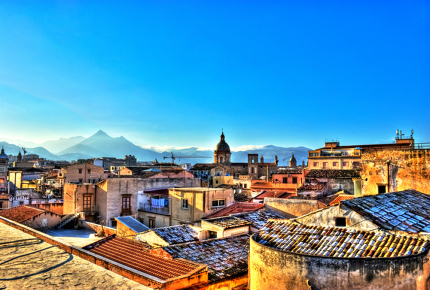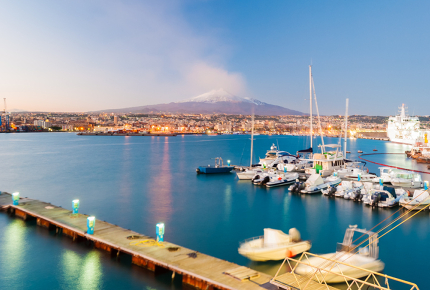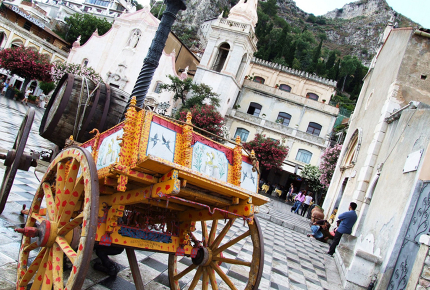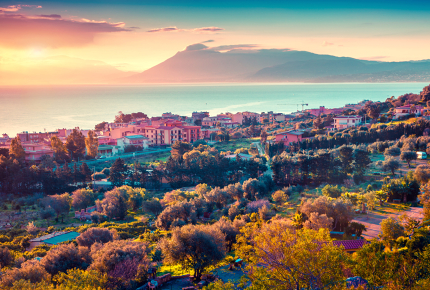An Insider's Guide to Sicily: Jewel of the Mediterranean
The largest island in the Mediterranean, Sicily boasts dramatic coastlines and rugged interiors that are soaked in dazzling sunshine most of the year.
Many visitors stick to Sicily's seaside resorts, but there is so much more to the island than beaches. Hire a car and go speeding down winding country roads, pausing to drink in the heady vistas, such as olive-coloured fields dotted with groves of orange and lemon trees or solitary hamlets standing in the shadow of a mountain-strewn horizon. Make sure you don't miss out on these sights and flavours, too.
In the Valley of Temples
Halfway down the southern coast is Agrigento and the Valley of Temples, one of the best-conserved sites of Ancient Greek architecture. Then there's the brooding presence of Mount Etna, whose hulking craters are well worth trekking up to; local companies offer guided tours through the countryside and mountains.
Sicily's natural wonders may be what attracts visitors, but the cities are worth spending time in too. The largest, Palermo, is chaotic and sprawling, but it's also home to the island's most beguiling Norman-Byzantine architecture. Expect ancient churches, crumbling but charming palaces and gorgeous time-worn piazzas. For a taste of the high life in this ancient city, visit Voyage Privé for excusive deals on four and five-star accommodation in Palermo.
 Palermo is Sicily's cultural and economic capital
Palermo is Sicily's cultural and economic capitalcannatella / Thinkstock
A Sicilian experience
When it comes to the people, forget the movies and the myths – Sicilians are a warm and welcoming bunch. Their distinctive culture stems in part from a fascinating, near incomparable history. Early settlers were Greeks and Phoenicians, who were followed by the Romans, while the arrival of the Arabs in the 9th century left profound marks on the islanders. The remarkable Norman-Byzantine-Arab hybrid culture of the 11th and 12th centuries then followed.
Perhaps because of this complicated history, Sicily still stands out from the rest of Italy, and not just for the widely spoken Sicilian dialect. The people have a reputation for being passionate, direct and superstitious, though city folk are increasingly cosmopolitan. As in other matters, Sicilian cuisine is more potent than in the Italian mainland, with pasta sauces tending to come laced with seafood and chilli, and pastries that seem more Middle Eastern than European.
Two staples are arancini – risotto balls caked in breadcrumbs often filled with ragu, mozzarella and peas – and cannoli – a crispy tube stuffed with ricotta. Both are thought to have Arab origins. Other dishes include the Sicilian version of pizza, sfincione, which has a thick crust, and pasta con la sarde, spaghetti with sardines, pine kernels and white fennel. Try it at the homely Trattoria Ai Cascinari (Via D'Ossuna, 43/45) restaurant near the imposing Porta Nuova, the city gates built for Palermo in 1570.
 The ancient port city of Catania
The ancient port city of Cataniabdsklo / Thinkstock
On the other side of the island to Palermo, about halfway up the east coast, lies Catania. The second city prides itself on being the cultural and intellectual superior to Palermo, and it certainly does strike a different note. Its Baroque buildings of black lava and white limestone are unique, while the main dish is pasta alla Norma, which consists of short pasta with ragu, aubergine, ricotta, and unlike in Palermo, not a sardine in sight. Catania is also the ideal base from which to explore nearby Mount Etna.
The home of Plato
Elsewhere on the island, don't miss Syracuse, once upon a time the greatest city in the Ancient Greek world. Dating back to around 733BC, the town was founded by settlers from Corinth and went on to become the mightiest western city state of the Greeks. Plato and the playwright Euripides both called Syracuse home, and its archaeological park, Ancient Greek theatre and beautiful old town make it an essential stop. A tangle of cobbled streets with a jumble of Roman, Baroque and medieval architecture, the old town is based on an islet connected to the bustling modern Syracuse by two slender, handsome bridges.
 Taormina's Piazza IX Aprile on Sicily’s east coast
Taormina's Piazza IX Aprile on Sicily’s east coastCreative Commons / gnuckx
If the potent flavours and sun-kissed vistas all get a bit much, throw yourself onto the golden sands of Cefalú, the popular beach resort not far from Palermo. For something closer to the castaway experience, head east to the city of Milazzo, where you can take a boat to an archipelago known as the Aeolian Islands. The cliffs jutting into deep-blue sea are something straight out of Homer's Odyssey, in which Sicily appears more than once.
If you somehow haven't found the Sicilian idyll in any of the above, there are any number of classic towns dotted around the island to choose from. The Val di Noto area is strewn with pretty Baroque villages, while the mountains harbour charming fortified towns offering precious glimpses of the past.
Looking for travel with a touch of luxury in 2017? Visit Voyage Privé for exclusive deals on accommodation in Sicily and around the rest of the world.
 The seaside hamlet of Solanto
The seaside hamlet of SolantoAndrew Mayovskyy / Thinkstock
Do you have any Feedback about this page?
© 2025 Columbus Travel Media Ltd. All rights reserved. No part of this site may be reproduced without our written permission, click here for information on Columbus Content Solutions.









 You know where
You know where